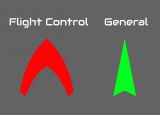Raise Shields! Damage Report!
Hello again! Today I'd like to talk about Rank: Warmaster's defensive strategies and mechanics, as well as how the game models the damage you take from all those lovely weapons I discussed last time.
Before a ship take damage, there are a couple of tricks that can keep it out of harm's way. Ships can be fitted with two engine types, main thrusters and inertial thrusters. Main thrusters provide powerful forward thrust and enable a ship to afterburn for a massive boost of speed, consuming large quantities of power in the process. With good reactions, a player with strong main thrusters can turn and afterburn to outrun a missile barrage until the ordnance runs out of fuel. Inertial thrusters allow a ship to move in any direction, but are more expensive and don't allow a ship to afterburn. A large bank of inertial thrusters can allow a ship to effectively bob and weave to dodge incoming projectiles while still returning fire, making this a powerful strategy for dogfighting. Ships can, and typically are, equipped with both main and inertial thrusters and the player can decide on what balance between raw speed and maneuverability they desire.
No ace avoids taking damage forever, so next up is armor and shields. Shields are powerhungry and expensive, but have the advantage of slowly regenerating themselves over time. Armor is cheaper but doesn't repair itself in combat and is generally heavier, slowing a ship down unless compensated for by fitting larger thrusters. Both take damage on a per-polygon basis, so attackers can blow through shields or armor in specific locationd and then attempt to continue targeting those locations. To combat this the pilot has granular control of their shields and the ability to shift power between different sides of the ship, and even to reduce shield strength shipwide in exchange for boosting shield regeneration to shore up dangerous breaches in the shield array.
Once a ship's defenses have been fully breached, damage will begin to be applied to it's internal components. The player arranges their components on a grid when designing a ship, so location matters! If a component takes enough damage to destroy it, it will explode and damage other nearby components, potentially causing a cascade of destruction. There are bulkheads meant to soak up punishment that can be placed on the ship design grid in order to shield fragile components, clever placement can help prevent catastrophic failure from a single unlucky hit, and the player can research modifications to existing components that both harden them against damage and reduce the blast when they are destroyed. Ships are more likely to become disabled during combat rather than outright explode, although taking out a ship's reactor core almost always results in one of the two.
Moving foward, we'll be looking into even more ways to help players defend their ships, such as point-defense guns that will shoot down incoming missiles and various styles of armor and shielding that function better again different damage types. Conversely, we'll also be working on features for more effectively dismantling opponents, such as advanced targetting that allows a pilot to know where to shoot to hit specific components for maximum effect. Until next time!
| Print article | This entry was posted by Adam on 09/30/19 at 04:41:00 pm . Follow any responses to this post through RSS 2.0. |

